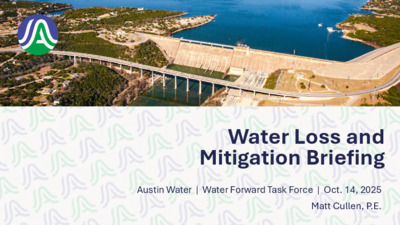3_Update on Austin Water's water distribution system water loss and mitigation — original pdf
Backup

Water Loss and Mitigation Briefing Austin Water | Water Forward Task Force | Oct. 14, 2025 Matt Cullen, P.E. Agenda • • • • Overview Water Loss Factors – 2023-2024 Actions to Reduce Water Loss Next Steps Overview Austin Water’s water distribution system includes: 4,018 miles of pipeline Pipes range in size from 2-inch to 84-inch diameter Our multi-pronged approach to reduce sources of water loss: On-going participation in industry best practices and innovations Fast response to reported leaks Infrastructure renewal investments Proactive leak detection 3 Water Loss Trends & Goals 10.00 9.00 8.00 7.00 6.00 5.00 4.00 3.00 2.00 1.00 FY 08 FY 09 FY 10 FY 11 FY 12 FY13 2014 2015 2016 2017 2018 2019 2020 2021 2022 2023 2024 Infrastructure Leakage Index (ILI) WF Goals 4 Water Loss & ILI Terms ILI is an industry performance indicator calculated as the ratio of Current Annual Real Losses to Unavoidable Annual Real Losses Real Losses: Water lost from system leaks and pressure-related issues. Unavoidable Annual Real Losses: The theoretical minimum level of water loss through all feasible leakage control efforts, regardless of cost. Unavoidable Loss is based on system-specific factors: miles of water mains number of service connections average annual system pressure Apparent Losses: Water that is distributed to a user but isn't accurately measured or billed. Results in lost revenue rather than a physical loss of water. 5 Water Loss Factors 2023 – 2024 30% increase in calculated water loss attributed to: Improvement in production flow measurement (0.5-1.0 billion gallons, or a 7-14% increase) Updated reporting of municipal water use (0.816 billion gallons, or an 11% increase) Increased “Real” Real Loss (0.376-0.876 billion gallons, or a 5-12% increase) 6 Actions to Reduce Water Loss In 2023, Black & Veatch was contracted to analyze our Water Loss Program The final 2024 Black & Veatch Report offered 32 recommendations: 9 are Complete or Operationalized 15 are In Progress 8 prerequisite items are In Progress 7 Leak Detection Practices Evaluate entire system every 6 years Explore more targeted approaches Continue large diameter leak detection & condition assessment Complete leak detection SOPs that include: Contract standards Data management Ongoing staff training Piloting new technologies Inspecting ARV’s, valves & vaults on transmission mains Research and pilot pressure transient monitors Implement pressure reducing valve monitoring Hire Engineer to lead Water Loss Program 8 System Renewal Understanding Your Water Service Line 9 System Renewal: Water Mains Continue investment in renewing poor performing water mains: FY26-30 budget includes $49M for main replacements 30 25 20 15 10 5 0 Main Break History 2011 2012 2013 2014 2015 2016 2017 2018 2019 2020 2021 2022 2023 2024 AW Breaks/100 miles Industry Avg Breaks/100 Miles Optimized Utility Breaks/100 Miles 10 System Renewal: Service Lines Increase focus on Service Lines: FY21-25 Service Line replacement budget: $8M FY26-30 Service Line replacement budget: $18M Leverage Texas Water Development Board $45M low interest loans 7 6 5 4 3 2 1 0 Service Line Break History 2011 2012 2013 2014 2015 2016 2017 2018 2019 2020 2021 2022 2023 2024 AW Breaks/1000 Services Industry Avg Breaks/1000 Services 11 Improve Production Flow Measurements Assembling and operationalizing SOGs to strengthen calibration and data handling processes to maintain and monitor accuracy. Studying configurations and performance to identify necessary capital improvements Instituting regular secondary production flow measurement for validation - consultant hiring underway Highland Lake System Austin Water Plant Production Flow Measurement Storage Distribution Use 12 Apparent Loss Tracking Document apparent loss control processes in an SOP that includes: Meter testing program validation (operationalized) Enhancement of large meter testing Proper meter sizing Meter replacement 13 Refining Tracking and Reporting Assemble SOPs for unauthorized consumption and data handling errors mitigation Evaluate transferring data from billing system to track water loss Refine system flushing and firefighting volume estimates Expand training for annual water audit and validation Continue to be active in water loss industry by attending national conferences and participating on committees Maintain high data validity scores 14 Utilize District Metered Areas District Metered Area: Section of a distribution system where all flows entering the area, and all demands in the area, are metered and monitored. We are conducting pilots to potentially create permanent District Meter Areas: Completed setting up two District Metered Areas Currently integrating District Metered Area and AMI data for automatic monitoring Once these fully implemented, we will create additional District Metered Areas 15 Centralized Data Management Finalize module for managing AMI generated data Create PowerBI dashboard for leak detection data Integrate SCADA, AMI, GIS, Logger detection software 16 Next Steps • Utilizing Effective Utility Management framework to implement recommendations from Black & Veatch report. • Broadening involvement in water loss tracking and reduction across the utility. • Working to comply with requirements of HB29. • Continuing to seek innovative approaches to reducing water loss. These activities will take time to have a noticeable impact on metrics but will result in reduced water loss. Thank you! Water